|
|
|
Sort Order |
|
|
|
Items / Page
|
|
|
|
|
|
|
| Srl | Item |
| 1 |
ID:
154196
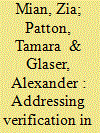

|
|
|
|
|
| Summary/Abstract |
The UN General Assembly last December called for negotiations this year to produce a "legally binding instrument to prohibit nuclear weapons, leading to their total elimination." The nuclear ban treaty talks will have to engage the issue of confirming compliance by the parties with the specific prohibitions established by such a treaty and, in addition, can establish guiding principles for the process of eliminating nuclear weapons and maintaining the resulting nuclear-weapon-free world.
|
|
|
|
|
|
|
|
|
|
|
|
|
|
|
|
| 2 |
ID:
192146
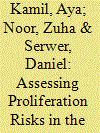

|
|
|
|
|
| Summary/Abstract |
Whether the Iran nuclear deal rises from the ashes or not, the United States and Europe now need to focus on preventing a nuclear arms race in the Middle East. Turkiye and Saudi Arabia are the most likely to respond to Iran’s becoming a nuclear-threshold state. Both have good reasons to think twice before proceeding, but their current leaders have made statements that arouse concern. Egypt might find it hard not to follow in their wake. With Israel and Iran, there would then be a prospect of five rivalrous nuclear powers in close proximity in a volatile region. Avoiding this scenario will require careful analysis of nuclear capabilities in the potential proliferating states; intense diplomacy among the US, Europe and the potential proliferators; and a broader regional-security framework for threat assessment that does not exist today.
|
|
|
|
|
|
|
|
|
|
|
|
|
|
|
|
| 3 |
ID:
107371


|
|
|
|
|
| Publication |
2011.
|
| Summary/Abstract |
A planned civilian nuclear deal between China and Pakistan moved a step closer to completion, as the International Atomic Energy Agency (IAEA) Board of Governors on March 8 approved safeguards agreements for the two power reactors that would be involved.
|
|
|
|
|
|
|
|
|
|
|
|
|
|
|
|
| 4 |
ID:
165570


|
|
|
|
|
| Summary/Abstract |
India concluded a fresh safeguards agreement (INFCIRC/754) with the International Atomic Energy Agency (IAEA) in 2009. All aspects of safeguards measures including the items to be safeguarded were deliberated upon, to ensure that India’s safeguards agreement does not result in giving any flexibility to India to use safeguarded items for unsafeguarded activities. The safeguards agreement INFCIRC/754 came with many additional features. Some of them are a result of the IAEA’s efforts to bring uniformity to subsidiary arrangements and structure and format for reporting requirements. Other features reflect India’s readiness to extend the provisions of INFCIRC/754 to previous safeguarded facilities. There have been quite a good number of publications on the contents of INFCIRC/754. An attempt has been made in this article to critically study the text of INFCIRC/754 and analyse and interpret the safeguards provisions therein to assess their functionality, adequacy and effectiveness.
|
|
|
|
|
|
|
|
|
|
|
|
|
|
|
|
| 5 |
ID:
108629
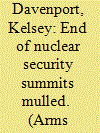

|
|
|
|
|
| Publication |
2011.
|
| Summary/Abstract |
The nuclear security summit process could end in 2014, a top adviser to President Barack Obama indicated last month.
In remarks at an Oct. 7 press briefing at the United Nations, Gary Samore noted that the first nuclear security summit, held in Washington in April 2010, endorsed the plan "to secure all vulnerable nuclear material around the world within four years," which Obama had announced a year earlier in a speech in Prague. "We do not intend to create a permanent institution with the nuclear security summit," said Samore, the White House coordinator for arms control and weapons of mass destruction (WMD) terrorism.
|
|
|
|
|
|
|
|
|
|
|
|
|
|
|
|
| 6 |
ID:
191976


|
|
|
|
|
| Summary/Abstract |
Over the past two decades, the international community has devoted considerable attention to the human dimension of nuclear security. This trend is part of a more holistic approach to securing nuclear facilities, grounded in the concept of culture, that moves beyond the traditional focus of physical-protection measures. But what explains this shift and what does it entail? This article begins by demonstrating, through a series of real-life case studies, the potential for human factors to undermine nuclear-security systems. It then considers the rise and consolidation of “culture” as a concept used to better understand and organize international efforts to strengthen nuclear security. Nuclear-security culture is then explored in practice, drawing on a review of relevant initiatives as well as empirical research conducted by the authors at several UK nuclear sites. A number of likely challenges for developing an effective nuclear-security culture at the operational level are discussed, as is the value of the culture-focused guidance developed by the International Atomic Energy Agency. The article concludes that while nuclear-security culture has been widely promoted at the international level, there exists considerable scope for new initiatives to further strengthen engagement at the working level of industry.
|
|
|
|
|
|
|
|
|
|
|
|
|
|
|
|
| 7 |
ID:
153901
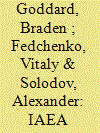

|
|
|
|
|
| Summary/Abstract |
The International Atomic Energy Agency uses a concept of “significant quantity” to establish accounting limits and to determine how much nuclear material can be unaccounted for before the construction of a nuclear device becomes possible. Under the current SQ values, some materials could potentially be under-regulated, while others have disproportionately tight accounting practices, thus interfering with optimal safeguards efficacy. This article compares the SQ values of various materials and reviews the categories adopted by a variety of national regulators to show similarities and differences of approaches. The article concludes by offering possible solutions to increase safeguards efficacy and reduce costs, while acknowledging potential drawbacks. All findings and conclusions are based on open-source publications and publicly available information.
|
|
|
|
|
|
|
|
|
|
|
|
|
|
|
|
| 8 |
ID:
117905
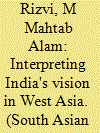

|
|
|
|
|
| Publication |
2011.
|
| Summary/Abstract |
India and Iran frequently cite the civilisational, cultural and historical ties that have bound the two countries together for more than a millennium. Both nations enjoyed strong bilateral relations following India's independence, overcoming such hindrances as Cold War politics and Iran's relationship with Pakistan. Iran and India enjoy friendly and consolidated ties that have led to greater stability in the region. The swiftly changing international surroundings and the associated strategic dimensions have been catalysts in forcing the two countries to reorient their foreign policies towards each other. However, much needs to be done to give economic and political support for a long term strategic direction to the bilateral relationship. This article seeks to capture the emerging orientation of India's relations with West Asia in general and Iran in particular. The article also examines the political, economic, cultural and security dimensions of the evolving relationship between India and Iran.
|
|
|
|
|
|
|
|
|
|
|
|
|
|
|
|
| 9 |
ID:
107364
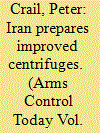

|
|
|
|
|
| Publication |
2011.
|
| Summary/Abstract |
Iran intends to begin its first full-scale testing of its second-generation centrifuge models, according to a Feb. 25 International Atomic Energy Agency (IAEA) report, a move that could allow Tehran to increase the rate at which it enriches uranium.
|
|
|
|
|
|
|
|
|
|
|
|
|
|
|
|
| 10 |
ID:
107379
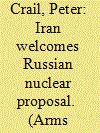

|
|
|
|
|
| Publication |
2011.
|
| Summary/Abstract |
Senior Iranian officials last month welcomed a Russian-proposed "step-by-step" process to address concerns about Iran's nuclear program, a move that could potentially restart talks between six major world powers and Iran.
|
|
|
|
|
|
|
|
|
|
|
|
|
|
|
|
| 11 |
ID:
121700
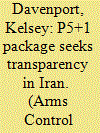

|
|
|
|
|
| Publication |
2013.
|
| Summary/Abstract |
The proposal six world powers brought to the April 5-6 talks with Iran over its controversial nuclear program contains transparency measures, including provisions that would require Iran to give inspectors increased access to facilities and provide information to address allegations of possible activities related to making a nuclear bomb, according to a former Iranian nuclear negotiator and two Western diplomats.
|
|
|
|
|
|
|
|
|
|
|
|
|
|
|
|
| 12 |
ID:
121704
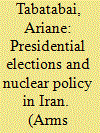

|
|
|
|
|
| Publication |
2013.
|
| Summary/Abstract |
The Iranian presidential election will take place on June 14. It will mark the end of Mahmoud Ahmadinejad's presidency, which was notable for controversies surrounding his second-term election and the tightening of the international community's backbreaking and unprecedented sanctions against the country, leading to the devaluation of Iran's currency.
|
|
|
|
|
|
|
|
|
|
|
|
|
|
|
|
| 13 |
ID:
155586


|
|
|
|
|
| Summary/Abstract |
Lack of knowledge is not an impediment to nuclear terrorism. Lack of nuclear material is.
Information on how to manipulate nuclear material to produce an explosive device—an improvised nuclear device, which would produce a nuclear explosion and a mushroom cloud, or a radiation-dispersal device, which would spread dangerous radioactive material over a substantial area—is now available widely enough that the only way to prevent nuclear terrorism is to keep terrorists from acquiring nuclear material or getting access to nuclear facilities.
|
|
|
|
|
|
|
|
|
|
|
|
|
|
|
|
| 14 |
ID:
174895


|
|
|
|
|
| Summary/Abstract |
The desirability and necessity of having a relook into the re-categorization of International Atomic Energy Agency (IAEA) defined High-Enriched Uranium (HEU) and Plutonium (Pu) by focussing on the relevance of strategic value/isotopic composition of the materials for re-categorization, for example, creating an intermediate category between the existing Low Enriched Uranium (LEU) and weapons-grade uranium (U-235 > 90 per cent) and re-categorizing plutonium into Weapons-Grade Plutonium (WGPU) and Reactor-Grade Plutonium (RGPU), specifying the content of Pu-240 in each case, had been suggested by various specialists. According to them, this re-categorization facilitates flexible IAEA inspection goals, does not compromise on safeguards efficacy and at the same time could result in reduced inspection efforts and costs. An assessment has been made from the available literature and it is possible to conclude that (i) only a relatively small enrichment effort is needed to enrich uranium with 20 per cent U-235 to weapons-grade uranium and (ii) non-weapons-grade plutonium can also be used in nuclear weapons. This article therefore argues that there is no need to change the existing IAEA categorization of HEU and Pu, and the current IAEA practices should continue for a more meaningful safeguards implementation. In addition, it is argued that technological advancements in safeguards verification, and pragmatic adaptation of integrated safeguards, state-level approach may bring about flexibility in safeguards approach. Further, it is suggested that with a large safeguards verification database at its disposal, the IAEA may take a decision on revising the value of Significant Quantity (SQ) without changing other criteria.
|
|
|
|
|
|
|
|
|
|
|
|
|
|
|
|
| 15 |
ID:
191977


|
|
|
|
|
| Summary/Abstract |
In 1991, international inspectors discovered Iraq’s clandestine nuclear-weapons program. In seeking this capability, Iraq was violating its commitment to the 1968 Treaty on the Non-Proliferation of Nuclear Weapons. After this discovery, the international community and the International Atomic Energy Agency worked to improve nuclear safeguards so that secret nuclear-weapons activities would be more easily detected in the future. One of these improvements was the 1997 Model Additional Protocol. This article explores the value of the Additional Protocol and argues that it is the strongest signal available to states that they support the nuclear nonproliferation regime and have benign nuclear intentions. The article then assesses the reasons why several notable holdout states remain.
|
|
|
|
|
|
|
|
|
|
|
|
|
|
|
|
| 16 |
ID:
102334
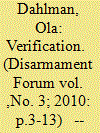

|
|
|
|
|
|
|
|